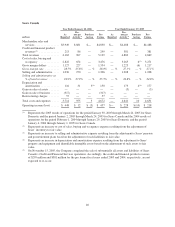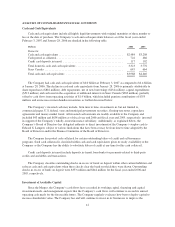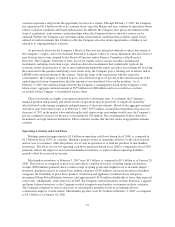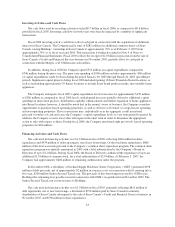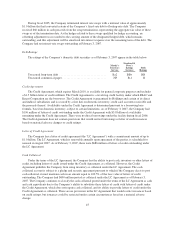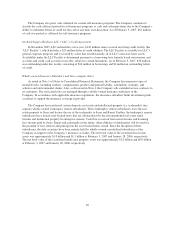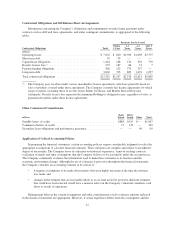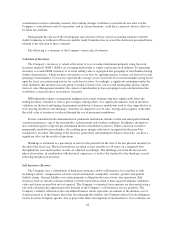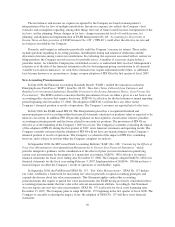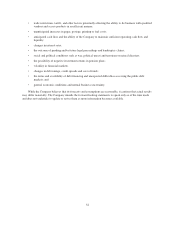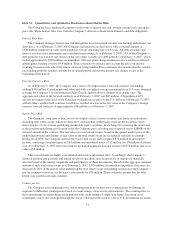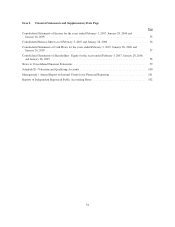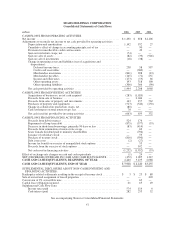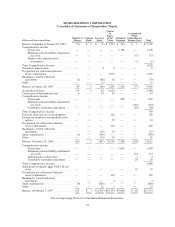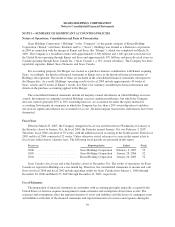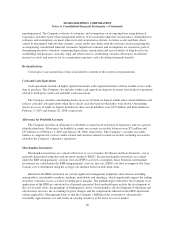Sears 2006 Annual Report Download - page 50
Download and view the complete annual report
Please find page 50 of the 2006 Sears annual report below. You can navigate through the pages in the report by either clicking on the pages listed below, or by using the keyword search tool below to find specific information within the annual report.The tax balances and income tax expense recognized by the Company are based on management’s
interpretation of the tax laws of multiple jurisdictions. Income tax expense also reflects the Company’s best
estimates and assumptions regarding, among other things, the level of future taxable income, interpretation of the
tax laws, and tax planning. Future changes in tax laws, changes in projected levels of taxable income, tax
planning, and adoption and implementation of FASB Interpretation No. 48, “Accounting for Uncertainty in
Income Taxes–an Interpretation of FASB Statement No. 109” (“FIN 48”) could affect the effective tax rate and
tax balances recorded by the Company.
Domestic and foreign tax authorities periodically audit the Company’s income tax returns. These audits
include questions regarding its tax filing positions, including the timing and amount of deductions and the
allocation of income among various tax jurisdictions. In evaluating, the exposures associated with its various tax
filing positions, the Company records reserves for probable losses. A number of years may elapse before a
particular matter, for which the Company has established a reserve, is audited and fully resolved. Management’s
estimates as of the date of the financial statements reflect its best judgment giving consideration to all currently
available facts and circumstances. As such, these estimates may require adjustment in the future, as additional
facts become known or as circumstances change, or upon adoption of FIN 48 in the first quarter of fiscal 2007.
New Accounting Pronouncements
In June 2006, the Financial Accounting Standards Board (“FASB”) ratified the consensus reached on
Emerging Issues Task Force (“EITF”) Issue No. 06-03, “How Sales Taxes Collected from Customers and
Remitted to Governmental Authorities Should Be Presented in the Income Statement (That is, Gross Versus Net
Presentation).” The EITF reached a consensus that the presentation of taxes on either a gross or a net basis is an
accounting policy decision that requires disclosure. EITF 06-3 is effective for the first interim or annual reporting
period beginning after December 15, 2006. The adoption of EITF 06-3 will not have any effect on the
Company’s financial position or results of operations. The Company’s revenues are reported net of sales taxes.
In July 2006, the FASB issued FIN 48. This Interpretation prescribes a recognition threshold and
measurement process for recording within the financial statements uncertain tax positions taken or expected to be
taken in a tax return. In addition, FIN 48 provides guidance on derecognition, classification, interest, penalties,
accounting in interim periods and disclosure related to uncertain tax positions. The provisions of FIN 48 are
effective as of the beginning of the Company’s 2007 fiscal year. The Company is currently evaluating the impact
of the adoption of FIN 48, during the first quarter of 2007, on its financial statements and operating results. The
Company currently estimates that the adoption of FIN 48 will not have any material impact on the Company’s
financial position or results of operations. The Company’s evaluation of the impact of FIN 48 is continuing,
however, and is subject to revision when the Company completes its analysis.
In September 2006, the SEC issued Staff Accounting Bulletin (“SAB”) No. 108, “Considering the Effects of
Prior Year Misstatements when Quantifying Misstatements in Current Year Financial Statements,” which
provides interpretive guidance on the consideration of the effects of prior year misstatements in quantifying
current year misstatements for the purpose of a materiality assessment. SAB No. 108 is effective for annual
financial statements for fiscal years ending after November 15, 2006. The Company adopted SAB No. 108 for its
financial statements for the fiscal year ending February 3, 2007. Implementation of SAB No. 108 did not have a
material impact on either the Company’s results of operations or stockholders’ equity.
In September 2006, the FASB issued SFAS No. 157, “Fair Value Measurements.” SFAS No. 157 defines
fair value, establishes a framework for measuring fair value in generally accepted accounting principles and
expands disclosures about fair value measurements. This Statement applies under other accounting
pronouncements that require or permit fair value measurements, the FASB having previously concluded in those
accounting pronouncements that fair value is the relevant measurement attribute. Accordingly, this Statement
does not require any new fair value measurements. SFAS No. 157 is effective for fiscal years beginning after
December 15, 2007. The Company plans to adopt SFAS No. 157 beginning in the first quarter of fiscal 2008. The
Company is currently evaluating the impact, if any, the adoption of SFAS No. 157 will have on its financial
statements.
50


